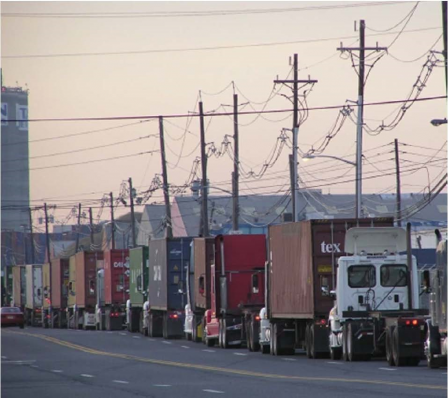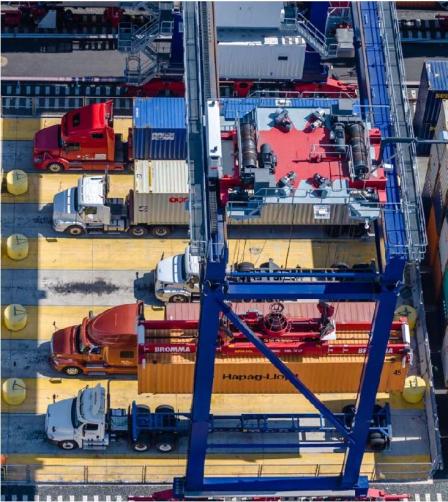GCT Bayonne’s Drayage Truck Appointment System
Some ports around the United States have implemented truck reservation systems and can see benefits in terms of cost savings, turn times, the environment, and congestion at or near the port. Global Container Terminals (GCT) has implemented an advanced truck appointment system at its GCT Bayonne facility that has realized benefits in these areas. Below is a summary of information provided by GCT Bayonne on their truck appointment system.
- Overview
- The problem
- The solution
- Reduced turn times, costs, air emissions, and congestion
- Lessons learned
Overview - GCT Bayonne in the Port of New York and New Jersey
The GCT USA’s Bayonne terminal is located in the Port of New York and New Jersey and is the first East Coast facility to introduce a truck appointment system. In 2014, GCT Bayonne underwent a significant upgrade to accommodate the largest ships calling the port through the Suez and the widened Panama Canal.
- In 2017, the Port of New York and New Jersey handled 6.7 million Twenty-foot Equivalent Units (TEU) of volume, with approximately 86% of this volume or 5.8 million TEUs handled by truck.
- GCT USA estimates it handled approximately 25% of the PANYNJ volume at 1.7 million TEUs.
The Problem: Congestion and Idling Emissions
 Drayage Trucks Lined-Up on City StreetHistorically, third-party motor carriers lined up for service on an unscheduled basis on city streets and highways surrounding the GCT Bayonne terminal. Truck arrivals were unpredictable, causing commuter congestion and excessive air emissions from idling.
Drayage Trucks Lined-Up on City StreetHistorically, third-party motor carriers lined up for service on an unscheduled basis on city streets and highways surrounding the GCT Bayonne terminal. Truck arrivals were unpredictable, causing commuter congestion and excessive air emissions from idling.
Leveraging the design, technology, and process improvements from its recent berth and landside modernization, the terminal’s yard and gate complex was further upgraded to accommodate a truck appointment system that would:
- Reduce truck idling;
- Introduce order into truck queuing at the terminal;
- Smooth street and highway traffic during peak hours;
- Improve and densify terminal capacity within the same footprint; and
- Eliminate unnecessary equipment.
The Solution: Truck Appointment System
At the outset, GCT was cognizant that introducing the appointment system at GCT Bayonne would be a big change for its drayage community. On January 15, 2017, they introduced the reservation system in phases as a strategy to gain user acceptance over time.
- In the first roll out, reservations were mandatory at the terminal for the first transactions of the day from 06:00-08:00.
- As more and more motor carriers began to subscribe to the system, reservation hours were phased in, one hour at a time.
- With the most recent expansion introduced in early November 2017, truck reservation hours were extended from 06:00-13:00 each weekday.
 Drayage Trucks Entering the Terminal GateAs GCT implemented this new system, incorporated enhancements improved the system’s versatility that resulted in a higher degree of acceptance among the truck carriers. The system provided the following:
Drayage Trucks Entering the Terminal GateAs GCT implemented this new system, incorporated enhancements improved the system’s versatility that resulted in a higher degree of acceptance among the truck carriers. The system provided the following:
- Predictability and increased efficiency for truckers through shorter and more consistent turn times – truckers can count on spending less time per ‘truck turn’ at the terminal,
- Over $5 million in fuel cost savings in 2017 alone,
- Priority scheduling benefitting customers, and
- The ability to meter traffic to manage traffic within the terminal.
Developing the System
GCT, the Sustainable Terminal Services (STS) Group and the Council for Port PerformanceExitdeveloped the appointment system through a multi-year collaboration. Comprised of the six container terminal operators in the port, the STS provided funding, collaborated with stakeholders, and owns the appointment system, with GCT Bayonne the first terminal to implement it.
Reduced Turn Times, Costs, Air Emissions, and Congestion
The reservation system has helped to reduce emissions without impeding economic growth at GCT Bayonne. By innovating how trucks are processed at the terminal, supply chain behavior has been positively influenced, while at the same time enabling trade and improving environmental performance. Since the program’s introduction, GCT estimates:
- Drayage truck turn times during appointment hours have improved more than 40%, while simultaneously improving the turn times of trucks outside of the mandatory reservation window,
- To date, more than 70% of GCT Bayonne’s truck transactions have an appointment, with more than 90% of the reservations kept.
Beyond improving efficiency, the new truck process smooths peak hour traffic as well as reduces truck idling time and harmful emissions. With mandatory appointments from 06:00-13:00 on weekdays, for the year 2017, GCT estimates the following savings:
- Carbon dioxide (CO2) reduction of 21,000 tonnes/year; the equivalent of taking 4,500 passenger cars off the road
- Overall air pollutant reductions of 61,000 kg/year
- Fuel cost savings of $5.3 million/year
Lessons Learned
Key ways to increasing efficiency include: optimizing crane utilization, eliminating unnecessary moves, and reducing distance travelled and dwell times when handling containers. These productivity gains can be enhanced through use of an appointment system, which can improve truck turn times through a terminal, reduce emissions from drayage trucks, and improve the efficiency of the supply chain.
Even though truck reservation systems were first introduced in North America in 2004, the more sophisticated appointment system was a new innovation for all stakeholders in the Port of New York and New Jersey. Lessons learned include:
- The phased approach to implementation gave each party time to learn the system and participate in shaping its structure.
- With a strong outreach program in place, trucking stakeholders were listened to and engaged, allowing GCT USA to learn and incorporate feedback, introduce enhancements, and improve the flexibility of the system.
With a strong participation rate from the drayage community, GCT is on its way to fulfilling its goal of implementing an entire day of reservations at GCT Bayonne.
